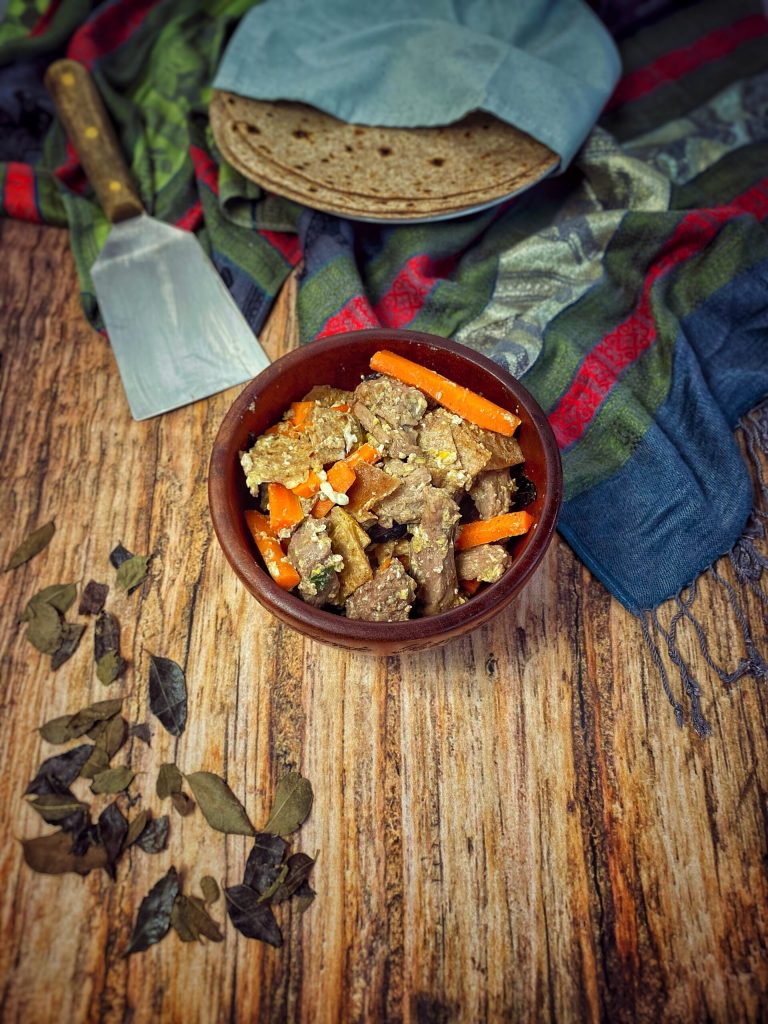Kottu (Tamil: கொத்து ரொட்டி; Sinhalese: කොත්තු රොටි), or Kottu rothi (also spelled Koththu or Kotthu), is a Sri Lankan dish made of broken rothi or paratha, mixed with onion and curry leaves, and a protein of choice (such as beef, mutton, seafood, chicken) along with scrambled eggs.
Served hot with a sprinkle of pepper.
Rothi is a type of flatbread called “Godhambara roti” or “Godamba roti” (also known as roti canai), which originates from Malaysia and is very similar to Indian paratha.
A variation of the dish is found in the southern Indian states of Tamil Nadu and Kerala, known as kottu porotta (Tamil: கொத்து பரோட்டா; Malayalam: കൊത്തു പൊറ ോട്ട), made using porotta instead of roti.
Recently, another South Indian dish, Idli, has also been cooked and sold this way as Kottu Idli.
The word koththu means “chop” in Tamil, referring to the preparation method, as the ingredients are chopped together using special cleavers while being sautéed on a hot plate.
When the chopped pieces of paratha or roti are finally added, they are chopped and mixed by repeatedly pounding with heavy iron blades/spatulas, the sound of which is very distinctive and can usually be heard from a long distance.
My version is with beef, but you can replace it with chicken or mutton.
In the video, the preparation of the one from my trip to Sri Lanka in October 2025.

- Difficulty: Medium
- Cost: Cheap
- Rest time: 30 Minutes
- Preparation time: 10 Minutes
- Portions: 4People
- Cooking methods: Stovetop
- Cuisine: Indian
- Seasonality: All seasons
Ingredients
- 14 oz Godhambara roti (or paratha)
- 18 oz beef (I used tenderloin)
- 2 eggs
- 4 cloves garlic
- to taste ginger
- 3 green chilies
- 2 carrots
- 10 curry leaves
- 1 onion
- to taste black pepper
- to taste vegetable oil
Steps
If you haven’t found paratha, you can prepare it following the recipe.
Marinate the beef with garlic, ginger, and chili for at least 30 minutes.
In a pan, sauté the onion in oil, add the garlic (3), ginger, chopped carrots, chili, and curry leaves.
Add the sliced beef.
Stir-fry for a few minutes.
Beat the eggs and add them.
Add the shredded roti (paratha) and mix with the vegetables and beef.
Stir frequently until the roti is fully coated with all the spices and vegetables.
Cook for about 5 minutes.
Serve sprinkled with black pepper.

FAQ (Questions and Answers)
Could the Arab and Persian influences during the Islamic expansion (7th-15th century) in Sri Lanka have had an impact on kottu? Or is it too recent?
The kottu as we know it is modern, but the concept of cutting flatbread, mixing it with spiced ingredients in a pan has cultural and technical parallels that could well have Arab/Persian origins, even if there is no direct documented link, for example, with dishes like fattoush.
Kottu Roti, in its current form, is a rather recent creation (1970s-1980s), born in post-colonial Sri Lanka, primarily as urban street food based on chopped roti, vegetables, eggs or meat, and spices. However, some components of it — flatbreads, quick pan-frying, intense spices, mixing of ingredients — could have more ancient roots and external influences.
• Arab and Persian cuisine: during the centuries of Islamic expansion, Arab and Persian communities brought with them:
flatbreads similar to roti or chapati
techniques of mixing and stewing with spices (e.g., kabsa, harees, thareed)
use of meats, onion, garlic, ginger, cumin, coriander — all ingredients common in kottu today.
• Influences from Tamil-Muslim cuisine in southern India, which in turn absorbed many Islamic influences (especially in the Tamil Nadu region and eastern Sri Lanka), where dishes based on chopped roti, similar (but not identical) to kottu, can be found.

